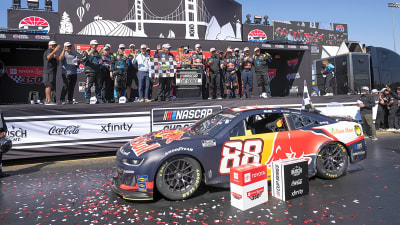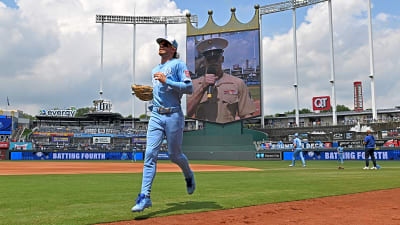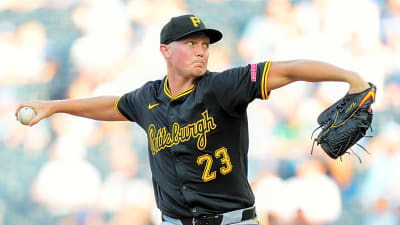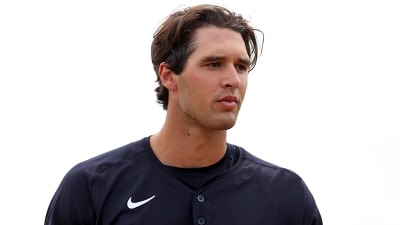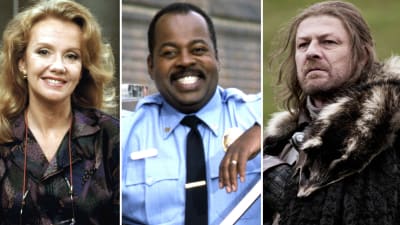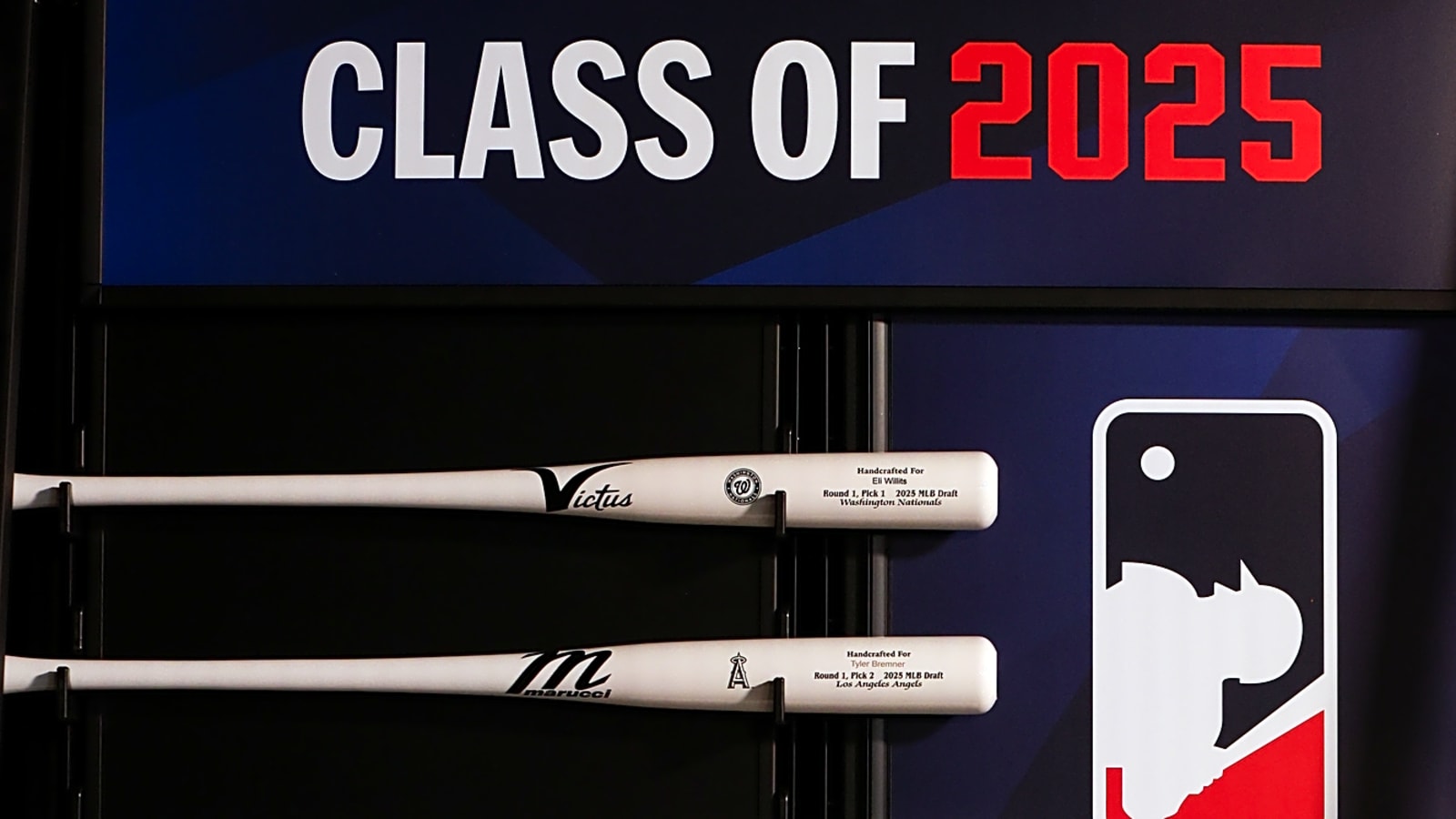
It’s draft season. Day 1 of the 2025 MLB Draft is in the books, as teams looked to make the most of the opportunity to add premium talent. Here’s our review — which I can’t promise will be short — of what went down during the first day.
Athletics
- 1st: Jamie Arnold (11th)
- 2nd: Devin Taylor (48th)
If you had said a year ago that the Athletics would have picked Jamie Arnold and Devin Taylor on the first day of the 2025 MLB Draft, that would have been a confusing statement. Why? The two were likely first-rounders last summer.
Arnold headed into the spring as arguably the best college pitcher — and maybe, the best pitcher available — in the country. The Florida State left-hander can overwhelm with a fastball/slider combo reminiscent of Chris Sale. However, his junior season saw him post the same ERA (2.98). Ground-ball pitcher, as well.
The Athletics drafted Indiana outfielder Devin Taylor, a well-known commodity, in the second round.
Taylor can hit with the wood bats, something that can be a concern for some who don’t perform in summer ball. The former Indiana outfielder did last summer in the Cape, as he slashed .296/.397/.510 (.907 OPS) with Cotuit.
Diamondbacks
- 1st: Kayson Cunningham (18th), Patrick Forbes (31st)
- 2nd: None
Like last year, the Diamondbacks had two first-rounders, one of which was used on a high schooler and the other on a college pitcher.
Arizona’s first pick was on Kayson Cunningham, the USA U18 World Cup qualifier team leader in average last summer. It’s an upside pick, and one used on a shortstop who one would hope develops into a good one.
The other first was used on Patrick Forbes, an oft-injured pitcher from Louisville with legitimate upside to a Major League starter. As I noted in our College World Series preview, it starts with a heavy fastball that sits in the mid-to-upper-90s with life and run, along with a sharp slider.
Braves
- 1st: Tate Southisene (22nd)
- 2nd: Alex Lodise (60th)
Atlanta went shortstop-heavy, going with two middle infielders.
The Braves started with Tate Southisene with the 22nd overall pick, the younger brother of Cubs prospect Ty Southisene. Tate has a flatter, shorter swing and may project to be a contact-first infielder. He’s also not a big player, at 5’11” and 180 pounds.
With the 60th overall pick, the Braves took Alex Lodise, a shortstop with pop who hit .394 with a team-high .705 SLG, buoyed largely by the 19 home runs he hit with the Seminoles.
Orioles
- 1st: Ike Irish (19th), Caden Bodine (30th), Wehiwa Aloy (31st), Slater de Brun (37th)
- 2nd: Joseph Dzierwa (58th), JT Quinn (69th)
It’s important to note that teams don’t draft for need. Hence, one should relax, even though the Orioles have plenty of catching depth. Baltimore, with four first-round picks, drafted catchers with their first two picks.
The first was Ike Irish, who moved to right field at Auburn and fit well there. He’s a big power guy, as he hit 19 home runs this season and is the calling card here.
Bodine, at #30, is more of a traditional catcher. He showed the ability to gun down runners and is a high OBP guy (.454), albeit not showing much power.
Wehiwa Aloy, at #31, struck out 64 times over 65 games this season but showed power at the shortstop position. Slater de Brun is an undersized outfielder but has shown to be very toolsy.
Baltimore went with two pitchers in the second round, including funky 6’8” left-hander Joseph Dzierwa. Dzierwa struck out 104 over 91 innings.
Red Sox
- 1st: Kyson Witherspoon (15th), Marcus Phillips (33rd)
- 2nd: Henry Godbout (75th)
Boston took one of the best pitchers in this year’s draft at #15, with Kyson Witherspoon.
Witherspoon’s been an elite arm for the past two seasons with the University of Oklahoma. He’s got a number of weapons to work with, including a mid-to-high-90s fastball and a slider.
Marcus Phillips, meanwhile, is a hard-throwing right-hander from the University of Tennessee. He’s more of a project, as his command problems were evident during his collegiate career. While he struck out 98 over 83 frames, Phillips walked 34 and surrendered 11 home runs.
The Red Sox took Henry Godbout, a New York City native from UVA, in the second round. Godbout was a career .321 hitter with the Cavaliers.
Cubs
- 1st: Ethan Conrad (17th)
- 2nd: Kane Kepley (56th)
The Cubs landed Wake Forest outfielder Ethan Conrad with the 17th overall pick.
Conrad, a shorter outfielder, albeit one who has explosiveness and power generated from his backside, dominated at Marist before moving to Wake Forest. However, he only played eight games with the Demon Deacons before season-ending shoulder surgery.
Chicago followed that pick up with another ACC outfielder: Kane Kepley. Kepley shined at Liberty in 2024, as he hit nine home runs and posted a 1.003 OPS with the Flames. However, the power numbers dipped significantly, with only a .153 ISO with the Tar Heels.
However, Kepley is an incredible runner who stole 45 bases this season.
White Sox
- 1st: Billy Carlson (10th)
- 2nd: Jaden Fauske (44th)
The White Sox didn’t pick until 10th, thanks to competitive balance rules. When Chicago ultimately got on the board, the White Sox took a high-upside bat with shortstop Billy Carlson, one of several players from Corona High School in California.
Carlson has the arm to stick at shortstop, as well as an intriguing power profile. It’s a bit of a long swing, something to watch to see if the hit tool lags as he moves up in the pros.
Chicago went high school against at #44, taking Illinois prepster outfielder Jaden Fauske.
Reds
- 1st: Steele Hall (9th)
- 2nd: Aaron Watson (51st)
The Reds appeared to have had recent luck with high schoolers — Sal Stewart & Cam Collier are examples of that. Cincinnati will hope Steele Hall will follow suit.
Hall is a high school shortstop with a strong arm; Perfect Game had him clocked in at 88 MPH three years ago. He’s also been given strong grades on his speed.
Guardians
- 1st: Jace LaViolette (27th)
- 2nd: Dean Curley (64th), Aaron Walton (66th), Will Hynes (70th)
Texas A&M outfielder Jace LaViolette headed into the spring as arguably the best bat available. However, the 2025 season didn’t go as planned. He batted only .258, struck out a lot, and didn’t take a step forward in his development.
On the other hand, he has natural plus power and that’s a big deal. If this pick hits, the Guardians may have made out great.
Cleveland followed that pick up by taking Dean Curley and Aaron Watson, both of whom hit well this season, and Ontario prepster Will Hynes.
Rockies
- 1st: Ethan Holliday (4th)
- 2nd: JB Middleton (45th), Max Belyeu (74th)
Colorado now has Ethan after father Matt Holliday was a dominant force for the organization.
Look, Holliday has his flaws, namely, range. However, the power is legitimate, and he has the chance to be the organization’s next great star.
The Rockies took two college players in the second. JB Middleton is a ground-ball/fly-ball neutral pitcher but was a standout this past year for Southern Miss, with 122 strikeouts over 105 innings. Max Belyeu, who missed time with an injury in 2025, flashed power when healthy.
Tigers
- 1st: Jordan Yost (24th), Michael Oliveto (34th)
- 2nd: Malachi Witherspoon (62nd)
The Tigers went aggressive on high school players.
Their first pick was used on Jordan Yost, a Tampa-area shortstop who wasn’t on the summer showcase circuit last year. And, the Tigers did roughly the same thing with their next pick, taking Long Island catcher Michael Oliveto.
Oliveto, as noted by other outlets, shone in the WWBA World Championship in Jupiter last year. However, the New York prepster, who’s looking to join Logan O’Hoppe as Long Island catchers to go to the Majors, is a high-risk play. The high school competition in New York State isn’t strong compared to other locales.
Detroit took Malachi Witherspoon, the twin brother of Kyson, in the second round.
Astros
- 1st: Xavier Neyens (21st)
- 2nd: None
Houston had just one pick in the first two rounds. The Astros used it on Washington high school infielder Xavier Neyens.
It’s not hard to see why. Neyens, despite having a longer stroke — which could mean more strikeouts at the next level — has bat speed, which may make him a tantalizing power-hitting prospect as he grows.
Royals
- 1st: Sean Gamble (23rd), Josh Hammond (28th)
- 2nd: Michael Lombardi (61st), Justin Lamkin (71st)
The Royals focused on upside in the first round, going with Sean Gamble, who showed off bat speed as an amateur, out of the IMG Academy with their first pick. Josh Hammond, a high school shortstop from North Carolina, was taken 28th overall with the team’s PPI selection.
Kansas City went with two pitchers in the second round, both from the college circuit.
Tulane reliever Michael Lombardi put up gaudy strikeout numbers, as he struck out 73 over 42 frames for the Green Wave. Justin Lamkin, taken 10 picks later, posted a career 11.2 K/9 despite uneven ERA numbers across three years with the Texas A&M Aggies.
Angels
- 1st: Tyler Bremner (2nd)
- 2nd: Chase Shores (47th)
The MO for the Angels over the last few years has been to target high-upside collegiate players. Zach Neto, Christian Moore, and Nolan Schanuel fit that bill. Now, add Tyler Bremner to that mix.
Los Angeles took Bremner, from UC Santa Barbara, with the second overall pick, bypassing some of the other notable arms like Jamie Arnold and others I’ll get to in a second. Bremner’s got great stuff, including a plus-plus change with nearly a 50% Whiff% in college.
However, Bremner worked as a starter & reliever in college. And, there are questions whether he can stick as a starter if he can’t get another pitch to level out his fastball & changeup.
The Angels selected Chase Shores at #47. He’s got a big arm and struck out a healthy chunk of batters at LSU, with 70 over 63 innings. However, he missed all of 2024 due to injury, didn’t pitch a lot in college — only 82 career innings — and had command problems (4.4 BB/9).
Dodgers
- 1st: Zach Root (40th), Charles Davalan (41st)
- 2nd: Cam Leiter (65th)
A pair of Razorbacks are going to Los Angeles.
Zach Root, the former ECU left-hander, pitched very well in the SEC this season. Root, who can sit in the mid-90s with this fastball and gets outs with the secondary stuff, including a sharp curveball, struck out 126 batters this season for Arkansas.
Charles Davalan, a power-hitting outfielder this season, joined him one pick later.
The Dodgers took FSU pitcher Cam Leiter with their second-round pick.
Marlins
- 1st: Aiva Arquette (7th), Cam Cannarella (43th)
- 2nd: Brandon Compton (46th)
For the Marlins’ sake, a lot lies on Aiva Arquette.
Arquette comes over to Miami after a standout season with Oregon State. He hit 19 home runs and hit .354 for the Beavers, showing the kind of power one would want to see from an elite prospect.
Their second pick was on Clemson outfielder Cam Cannarella, a flummoxing prospect. Cannarella is an elite defensive outfielder but didn’t produce enough offensively to get into the top-30.
Brandon Compton, from Arizona State, hit .331 (.903 OPS) with six home runs in the Cape Cod League last summer.
Brewers
- 1st: Andrew Fischer (20th), Brady Ebel (32nd)
- 2nd: JD Thompson (59th), Frank Cairone (68th)
Two years ago, the Brewers took Brock Wilken, a power-hitting corner infielder, in the first round. This year, it’s Andrew Fischer, an exceptionally disciplined power hitter with premium bat speed. However, he may grade out with a 40 hit tool.
Their second first-rounder was used on Brady Ebel, a high school-famous player and son of Dodgers third base coach Dino Ebel.
Milwaukee went with J.D. Thompson, a well-known pitcher from Vanderbilt, with their first second-round pick, before going back to New Jersey to select prep pitcher Frank Cairone.
Twins
- 1st: Marek Houston (15th), Riley Quick (36th)
- 2nd: Quentin Young (54th)
Marek Houston is an interesting shortstop, one with likely a power tool that’ll grade out 50. He’s also a terrific defensive shortstop. However, the hit tool will be something to watch.
Their second first-rounder was used on Alabama pitcher Riley Quick, who showed an explosive fastball/slider combo.
Mets
- 1st: Mitch Voit (38th)
- 2nd: None
The Mets have had luck with two-way players, with Nolan McLean being a recent example. Mitch Voit, announced as a two-way player, could be the next one.
Voit, a second baseman, hit very well at the University of Michigan and improved statistically every season. This past year, Voit hit .346/.471/.668 and showed power. The new Met hit 14 home runs in each of the last two seasons.
Yankees
- 1st: Dax Kilby (39th)
- 2nd: None
Like the Mets, the Yankees only had one draft pick in the top two rounds.
The reigning AL champions used their pick on Dax Kilby, a projectable high school shortstop who could add more muscle to his presently wiry frame. He doesn’t, however, look like a power hitter at the moment, as he doesn’t use the back side as much as he could.
Phillies
- 1st: Gage Wood (26th)
- 2nd: Cade Obermueller (63rd)
Philadelphia took Gage Wood with the 26th overall pick. Wood was a star late for the Razorbacks, thanks in large part to a devastating fastball that plays up and can run to 97-99 MPH.
The pick of Wood also ends a run of prepsters the Phillies have been on in recent years, when it comes to first-rounders.
Cade Obermueller, one of the top strikeout pitchers in the NCAA this season, is the son of former Major Leaguer Wes Obermueller. He didn’t sign with the Rangers, who drafted him in the 19th round last year.
Pirates
- 1st: Seth Hernandez (6th)
- 2nd: Angel Cervantes (50th), Murf Gray (73rd)
Once again, a reminder that teams don’t take for need in the MLB Draft.
Seth Hernandez is yet another pitching prospect in the Pirates’ system. Hernandez, from Corona HS (CA), is an impressive pitcher with a hard fastball, coupled with a curveball and changeup. He was under early consideration this spring for the Golden Spikes Award.
The Pirates did, however, take a bat at #73 with Murf Gray, 23 picks after picking California high school pitcher Angel Cervantes.
Gray was a standout last summer in the Cape, as his 46 hits were the second-most in the circuit.
Padres
- 1st: Kruz Schoolcraft (25th)
- 2nd: None
Dating back to his days with the Rangers, AJ Prellar-affiliated front offices love the high-upside high schooler. Hence, it’s not a shock to see the team take Kruz Schoolcraft.
Schoolcraft can overwhelm hitters with a hard fastball. He’s also one of the most physically impressive pitchers in this year’s draft at 6’8” and nearly 230 pounds. That size, however, can come at a price if he can’t repeat his delivery as a professional.
Giants
- 1st: Gavin Kilen (13th)
- 2nd: None
The Giants didn’t have a second-round pick (but did have a third, and took contact-first Rutgers outfielder Trevor Cohen), so #13 was the only pick for the team in the first two rounds.
San Francisco used it on Gavin Kilen, a 5’11” infielder from Tennessee who hit everywhere he played, including in Louisville and Knoxville.
Mariners
- 1st: Kade Anderson (3rd), Luke Stevenson (35th)
- 2nd: Nick Becker (57th)
Add another high-end pitching prospect to the Mariners’ farm system.
Kade Anderson has a lot of weapons up his sleeve, including a curveball and a fastball that plays up. It’s why Anderson, who led Division I in strikeouts (180) and did so in the SEC, got drafted here despite not having an “eye-popping” fastball.
With their second pick, the Mariners took UNC catcher Luke Stevenson. Stevenson is a big power hitter, as he belted 19 home runs this season. However, the 70 strikeouts over 61 games are an indication that the hit tool may not be as strong.
New Jersey prep shortstop Nick Becker went in the second round.
Cardinals
- 1st: Liam Doyle (5th)
- 2nd: Ryan Mitchell (55th), Tanner Franklin (72nd)
St. Louis may have found their future ace with Liam Doyle.
Doyle finished second in Division I in strikeouts (164) this season, thanks in large part to a booming fastball that can touch the triple digits. Production like that, particularly in the SEC, will entice scouts.
The Cardinals went with a high school outfielder, Ryan Mitchell, at #55. Tanner Franklin, a hard-throwing reliever and teammate of Doyle at Tennessee, rounded out the second round.
Rays
- 1st: Daniel Pierce (14th), Brendan Summerhill (42nd)
- 2nd: Cooper Flemming (53rd), Dean Moss (67th)
This was a fairly typical Rays draft, one where the team gets high-upside high schoolers with standout tools, coupled with a “safe” college player.
A case in point is with Daniel Pierce, a shortstop considered to have plus speed. Tampa followed that up with high schoolers Cooper Flemming (shortstop) and Dean Moss (outfielder).
The Rays took Brendan Summerhill, a good overall hitter, from Arizona with the 42nd overall pick.
Rangers
- 1st: Gavin Fien (12th)
- 2nd: A.J. Russell (52nd), Josh Owens (84th)
The Rangers leaned in with the bloodline players this year. Texas took Josh Owens, the son of ex-Minor Leaguer Jeremy Owens in the second round. And in the first, Gavin Fien, the younger brother of Athletics prospect Dylan Fien.
Fien’s an interesting player. He’s 6’3” and projectable. However, he does like to keep those arms up high and stands upright, rather than crouching down to get more athletic at the plate.
Texas picked A.J. Russell, an arm with upside who pitched well with the University of Tennessee when healthy,
Blue Jays
- 1st: JoJo Parker (8th)
- 2nd: Jake Cook (81st)
Toronto loves their high-upside players, as evident when the team took Arjun Nimmala, an uber-talented power hitter.
This year, the Jays took high school shortstop JoJo Parker. He’s a sizable player at 6’2” and 200 pounds.
Their second-round pick was pitcher-turned-outfielder Jake Cook from Southern Miss. Cook hit .350 with the Eagles this season and per the league, turned in the best 30-yard-dash time (3.51s) at this year’s MLB Draft Combine.
Nationals
- 1st: Eli Willits (1st)
- 2nd: Ethan Petry (49th)
We end with the first team to select on draft day, the Nationals.
Washington opted to go with Eli Willits, the Oklahoma star prepster with speed, a great hit tool, and like Holliday, MLB bloodlines. At the same time, though, this was likely a below-slot deal to save for other picks.
Ethan Petry, as #49, has been college-famous for a while. Petry is a hulking figure at 6’4” and 235 pounds, and is a plus power hitter. The former USC Gamecock led the Cape Cod League in OPS (1.240) last summer and tied for the lead in home runs (11).
He does strike a lot, however. Petry had 73 over 61 games two seasons ago.
Only Rounds 1-2 were considered for this article.
More must-reads:
- Family ties a big theme in first day of MLB Draft
- California high school makes MLB Draft history
- The 'MLB active strikeout leaders' quiz
Breaking News
Trending News
Customize Your Newsletter
 +
+
Get the latest news and rumors, customized to your favorite sports and teams. Emailed daily. Always free!
